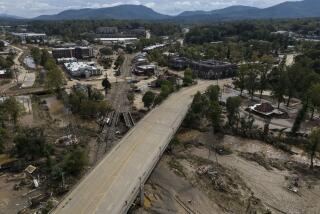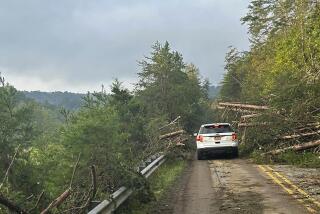State of shock
- Share via
Florida’s fourth hurricane in six weeks ripped its way across the state Sunday -- killing at least six, leaving millions without electricity and adding new woes to an already agonizing hurricane season.
Hurricane Jeanne drove ashore just before midnight Saturday with 120-mph winds on Hutchinson Island near Stuart, relentlessly retracing a path carved three weeks earlier by Hurricane Frances and subjecting Central Florida to a long day of punishing winds and drenching rain that added to flooding fears. More than 3.5 million Floridians were without electricity late Sunday night.
Gov. Jeb Bush promised prompt help to those affected by the storm and tried to bolster spirits sagging after yet another assault by a major hurricane in a season that doesn’t end until Nov. 30.
“This will become a memory,” Bush said during a tour of coastal areas hit by Jeanne. “This does come to an end, and when it does, we can probably use the term ‘normal’ again.”
Rescue workers were still searching the ruins of mobile homes in several counties and beachfront houses and condominiums on barrier islands where Jeanne’s storm surge blew out walls and left drifts of soggy sand 5 feet deep.
“You’d think it was snow,” said Tim Rovero, 63, who rode out the storm in his Hutchinson Island home.
Rovero said he has lived through plenty of fierce storms before, “but this is the worst one yet.”
The Federal Emergency Management Agency said Sunday that recovery efforts from the hurricanes that have struck Florida are now the largest deployment in its history, topping even the Sept. 11, 2001, terror attacks.
Jeanne, which formed as a tropical storm Sept.|14, already was blamed for more than 1,500 deaths in the Caribbean before it made a slow loop in the Atlantic and turned to strike Florida.
In Florida, the unofficial death toll included an unidentified 60-year-old Brevard County man who police said passed out into ankle-deep water during a hurricane party, a man found in a rain-swollen ditch in Palm Bay, a man electrocuted in Miami by touching a downed power line, a 15-year-old boy pinned by a tree in Clay County and two people who apparently drowned when their sport utility vehicle plunged into a lake near Fort Lauderdale.
Charley, Frances and Ivan, Jeanne’s three predecessors this season -- the first in which four hurricanes have struck one state in a season since Texas was hit similarly in 1886 -- were blamed for a total of 88 deaths in Florida.
In Orange County, damage from Jeanne appeared much lighter than from Hurricane Charley, which struck in August. Forecasters said metro Orlando was spared Jeanne’s worst when the hurricane’s path went farther west than expected before making a northerly turn.
“We were fortunate when we went to bed last night and the hurricane took a different path,” Orlando Mayor Buddy Dyer said.
But other communities weren’t so lucky. Jeanne pounded coastal areas with huge waves, washing away long sections of beach already depleted by Charley and Frances and by surf churned ashore during Jeanne’s long circle through the western Atlantic.
In Vero Beach, where many roads remained impassable because of high water and debris Sunday, officials could not say how many buildings might have been damaged or destroyed. But Bush said the area “was probably pretty close to where the maximum damage was done.”
In St. Lucie County, where Jeanne made landfall, officials said the entire county lost power. Police rescued five families, including a couple in their 90s whose mobile home collapsed around them, spokeswoman Linette Trabulsy said.
In Volusia County, authorities found two teenage boys who had been reported missing in the Halifax River. St. Lucie County officials were investigating reports that a car was blown into the water while crossing one of the bridges over the Indian River in the middle of the storm.
Jeanne’s route made it the third hurricane this year to traverse Polk County, where the paths of Charley, Frances and Jeanne intersected. Polk County officials said Sunday that damage from Jeanne appeared to be the worst of the three.
In Barefoot Bay, a community of 4,900 mobile homes south of Melbourne, trustee Bob Carillon, 65, said Jeanne damaged nearly every home.
Even far from Jeanne’s eye, the Category 3 storm spun off winds powerful enough to down trees and peel shingles from roofs.
At Orlando International Airport, National Weather Service instruments recorded gusts of 76 mph at 11:45 a.m. and 12:52 p.m. Sunday. At Melbourne, about 60 miles north of Jeanne’s landfall, weather-service instruments recorded a gust of 79 mph at 3:18 a.m. Sunday.
Many structures succumbed to the multiple maulings by the hurricanes, as at the Ramada Inn in Satellite Beach, where Jeanne finished what Frances started.
The first storm tore off half of the coral-colored north wall, leaving only metal framing and air between the outdoors. Jeanne tore the covering off several more floors, leaving hotel blankets, carpet and sheets flying in the wind.
At Kennedy Space Center, Jeanne ripped more exterior panels from the massive 52-story Vehicle Assembly Building, where Frances already had ripped away 10,000 square feet of the building’s siding.
“We have a lot more open areas than we did before,” said KSC spokesman George Diller, who said NASA’s three space shuttles were not damaged.
President Bush declared 19 counties disaster areas, including Orange, Osceola, Seminole, Brevard, Lake and Volusia. It was his fourth such declaration for the state in six weeks.
“These people in Florida have gotten beaten to death,” FEMA Director Michael Brown said. “Many have been hit by one storm after the next. It’s hurt their pocketbooks and their psyches.”
Some emergency officials had feared that fatigue from past hurricanes would persuade some in evacuation areas to ride out Jeanne. Evacuation traffic in the days before the storm struck appeared much lighter than during earlier storms, and only about 62,000 people went to public shelters, compared with about 97,000 during Frances.
Thad Cohen, secretary of Florida’s Department of Community Affairs, said he doubted the lower shelter numbers meant many ignored the evacuation orders. Instead, he said, many people probably sought refuge somewhere other than the often crowded, comfortless public shelters.
“Some folks may have stayed with friends and neighbors,” Cohen said.
But some residents who had evacuated for the previous storms said they decided to stay put for Jeanne.
“I got tired of moving,” said Dewey Hayes, who evacuated his mobile home at the River Forest Mobile Home Park south of Titusville for Charley and Frances but stayed home for Jeanne.
About 2 a.m. Sunday, the winds were at their worst, but not that bad, Hayes said.
“We got through it OK,” said Hayes, standing about 100|feet from where the Indian River lapped into the circular drive of his mobile-home park.
At Paradise Beach Club in Satellite Beach, Bill and Karen Miller emerged from their condo an hour after sunrise into pounding tropical-storm winds and rain to see the damaged hotel. Their power was knocked out at 4:30 a.m., so their morning coffee was prepared on a butane stove.
Like their friend Ed Osipowicz, they did not evacuate and said they did not regret their decision, despite the winds that battered their window all night, leaking in wind and water.
“We’re not crazy -- we all did a calculated risk assessment,” Osipowicz said.
Farther inland, Jeanne’s torrential rains -- unofficial estimates in some areas were more than a foot -- prompted fears of new flooding along the St. Johns River, already overflowing from Frances’ downpours.
In Sanford, Lake Monroe, a wide spot in the St. Johns, slopped over the sea wall along the city’s historic downtown Sunday, and much of Jeanne’s rain fell in sections of south Brevard and east Osceola counties that will feed the swollen river in coming days.
Heavy rains also may have contributed to a huge sinkhole that threatened businesses near Lakeland.
The 500-foot-wide hole damaged 11 businesses at the Lakeland South Center shopping plaza, including a Beef O’Brady’s restaurant, where the back wall and a new walk-in freezer stuffed with food had fallen into the hole.
At a nearby Outback Steakhouse, employees were feverishly hauling equipment out of the restaurant, concerned that part of the building might collapse.
Sean Mussenden, Maya Bell, Mary Shanklin, Bob Mahlburg, Christopher Sherman, Jim Stratton, Jason Garcia and Monica Scott of the Sentinel staff contributed to this report. John Glionna of the Los Angeles Times also contributed. Roger Roy can be reached at rroy@orlandosentinel.com or 407-420-5436.
More to Read
Sign up for Essential California
The most important California stories and recommendations in your inbox every morning.
You may occasionally receive promotional content from the Los Angeles Times.













